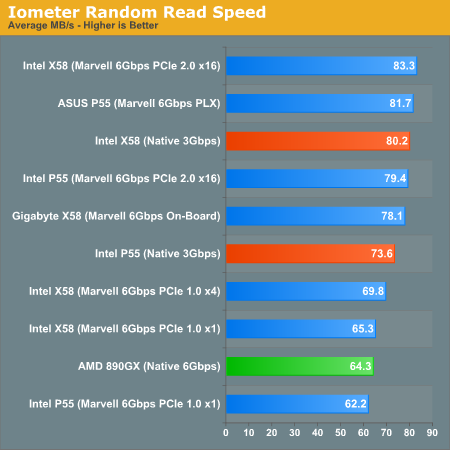6Gbps SATA Performance: AMD 890GX vs. Intel X58/P55
by Anand Lal Shimpi on March 25, 2010 12:00 AM EST- Posted in
- Storage
Random Read Performance is Also Affected
It’s not all about peak bandwidth either. Remember that bandwidth and latency are related, so it’s not all too surprising that the setups that delivered the least amount of bandwidth, also hurt small file read speed.
The target here is around 80MB/s. That’s what Intel’s X58 can do off one of its native 3Gbps SATA ports. Let’s see how everything else fares:

At 80MB/s the Crucial RealSSD C300 is pushing roughly 20,000 IOPS in this test. The highest random read speed of any MLC SSD we’ve ever tested in fact. With the 890GX the C300 can only manage 64.3MB/s.
Naturally I shared my data with AMD before publishing, including my Iometer test scripts. Running on its internal 890GX test platform, AMD was able to achieve a 4KB random read speed of 102.6MB/s in this test - faster than anything I’d ever tested. Unfortunately that appears to be using AMD’s own internal reference board and not one of the publicly available 890GX platforms. The good news is that if AMD’s numbers are accurate, there is hope for 890GX’s SATA performance. It’s just a matter of getting the 3rd party boards up to speed (AMD has since shared some more results with me that show performance with some beta BIOSes on 3rd party boards improving even more).
Using the Marvell 6Gbps controller in any PCIe 2.0 slot (or off a PCIe 2.0 interface as is the case with Gigabyte’s X58), or in one of ASUS’ 6Gbps ports behind the PLX switch, yields peak performance more or less.
Any of the PCIe 1.0 slots however saw a drop from ~80MB/s to ~65MB/s. The exception being Intel’s odd x4 slot that is a PCIe 1.0 slot, but branches off the X58 IOH and thus appears to offer lower latency than PCIe 1.0 slots dangling off the ICH.










57 Comments
View All Comments
Shadowmaster625 - Tuesday, March 30, 2010 - link
It sounds like AMD made a conscious decision to focus on maximum random write performance, even if it required sacrificing all other key performance metrics. I hope that is the case, because it is pretty sad that their 6 gbps controller is generally outperformed by a 3 gbps controller!astewart999 - Tuesday, March 30, 2010 - link
When talking performance, why are they not mentioning RAID 0. I suspect SATA3 is not capable?astewart999 - Tuesday, March 30, 2010 - link
Ignore my ignorance, I read the article then posted. Should have read the posts and ignored the article!nexox - Monday, April 5, 2010 - link
Just get a SASII (6Gbit) PCI-E HBA (LSI makes one, probably others) - plenty of speed, they generally run on a PCI-E 8x slot, and you can run SATA drives in them just fine. Plus they tend not to cost too much more than the consumer-level SATA adaptors, which are apparently questionable performance-wise. They'd at least make a good baseline for comparison.supremelaw - Saturday, April 17, 2010 - link
RS2BL040 and RS2BL080 are now at Newegg:http://www.newegg.com/Product/Product.aspx?Item=N8...
http://www.intel.com/products/server/raid-controll...
http://www.newegg.com/Product/Product.aspx?Item=N8...
http://www.intel.com/products/server/raid-controll...
Before buying, confirm whether or not TRIM will work with SSDs in RAID modes.
http://www.pcper.com/comments.php?nid=8538
*** UPDATE ***
The unconfirmed bit has been confirmed as unconfirmed from Intel:
“Intel® RST 9.6 supports TRIM in AHCI and pass through modes for RAID. A bug has been submitted to change the string that indicates TRIM is supported on RAID volumes (0,1,5,10). Intel is continuing to investigate the ability of providing TRIM support for all RAID volumes in a future release”
Looks like we'll have to wait a little longer for TRIM through RAID, but there *are* other SSD-specific improvements in this new driver.
*** END UPDATE ***
MRFS
chrcoluk - Saturday, June 19, 2010 - link
Ok my thoughts.1 - you written of pcie v1 however failed to notice or mention that the plx chip uses pci-e 1x lanes from the p55 chipset so clearly pci-e 1.0 can supply the bandwidth if utilised properly, the plx chip transfers 4 1.0 lanes into 2 virtual 2.0 lanes for the sata6g and usb3.
2 - some p55 boards, mine noticebly have a pci 2.0 slot fed of the p55 chipset @ x4 speed. Seems reviewers have got something wrong or are they claiming asus have it wrong? Even if we assume its actually pci 1.0 x4 that is still enough bandwidth to feed a sata 6g controller. Indeed the onboard plx which you praised sacrifices this x4 pci-e slot and uses those 4 lanes to feed itself. My thoery is the U3S6 card asus sell will perform the same as the onboard plx in a x4 slot but no reviewer has tested this properly.
3 - whats the reason you did not test both gigabytes onboard and the lower asus onboard which borrow bandwidth from the primary pci-e x16 lanes, I am looking for tests of those in both turbo/levelup and normal mode.
gimespace - Tuesday, August 8, 2017 - link
Try enabling DirectGMA with maximum GPU Aperture in Amd catalyst control center. It does not only make the graphics card faster but allowed me to get up to the maximum 560mb/s read speed for my ssd!